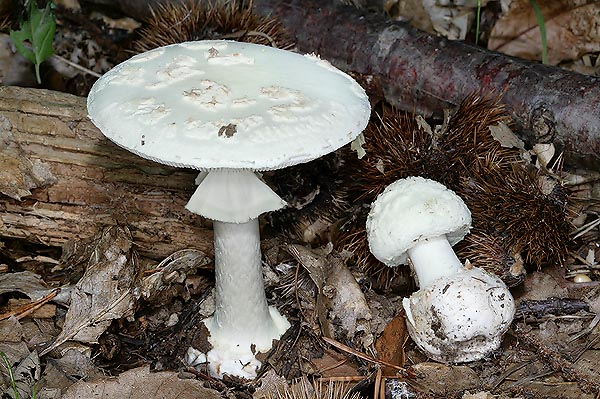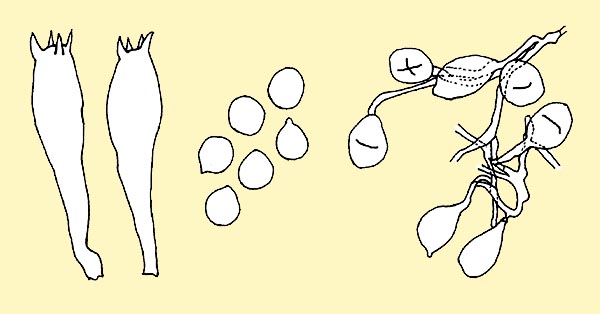
Text © Loredana Battisti

English translation by Mario Beltramini

Yellow-white cap with patchy or floccose decorations © Giuseppe Mazza
Family: Amanitaceae Roze
Genus: Amanita Persoon
Subgenus: Amanitina (Gilbert) Gilbert
Section : Mappae Gilbert
Amanita citrina (Schaeffer) Persoon 1797
The name of the species comes from the Latin citrum (=lemon), with reference to its colour.
The Section Mappae is characterized by basidiomata with general or universal veil with mixed hyphal structure: filamentous at the base and sphaerocystic in the upper half, so that with the growth the veil tears close to the margin of the cap, leaving some floccose remains on it; the other half remains at the base of the stipe in form of a volva adnate to the bulb, forming a “circumcised” small collar. Other characters which distinguish the Section are: non striated margin of the cap and base of the stipe
clearly bulbous.
Cap: 8-12 cm, normally fleshy, from globose to hemispheric to convex to flat, with smooth margin, pale yellow-white, citrine-yellow, at times with light green tones, smooth margin, with more or less decoration of small patches or whitish-cream floccosities, which can easily disappear, and brown when ripe.
Hymenophore: lamellae thick, free to stipe, with truncated lamellulae, white with light yellow reflexes, fully sharp, concolorous. Spore print white.
Stipe: 5-12 x 1-2 cm, generally slender, cylindrical, fistulous, enlarged at the base in a sub spherical-ovoid bulb, of white colour, with citrine tones. Ring wide and membranous, persistent, light yellow. Volva sub membranous, circumcised, wide, adherent to the bulb, light yellow-white.

Amanita citrina: basidia, spores, elements of the general veil © Pierluigi Angeli
Flesh: thick, compact, persistently white. Horse-radish, disgusting, smell.
Chemical reactions: amyloid spores in contact with Melzer’s reagent.
Habitat: ubiquitous, summer-autumn, latifolious woods (oaks, hazels, horn beams and chestnut trees), but also conifer ones.
Edibility: not edible, due to its bad horse-radish smell.
Notes: easily recognizable, due to its light-yellow colouring, smooth margin, bulbous volva clearly circumcised, unpleasant smell.
Varieties and similar species:
Amanita citrina var. alba (Price) Quelet & Bataille 1902, identical to the type, but completely white.
Amanita citrina for. crassior Massart & Rouzeau 1999, of bigger size, and habitat maritime pines.
Amanita asteropus Sabo ex Romagnesi 1963, from which it differs mainly for the big bulb clearly edged and pentagonal, star-shaped (from which the Latin name).
Remarks: In the old times, it was mistaken with the A. phalloides (poisonous-deadly), and consequently, considered as poisonous too, but, on the contrary, it is harmless, but uneatable due to its unpleasant smell. The Amanita citrina , easily mistaken with the A. phalloides , also because often they share the same growing area, differentiates for the following characters: big, bulky, bulb, circumcised volva, patches on the cap, horse-radish smell. The A. phalloides shows: sac-like volva, wide and free, glabrous cap with innate fibrils, furthermore does not have an unpleasant smell.
→ For general notions about Fungi please click here.
→ To appreciate the biodiversity of MUSHROOMS please click here.
